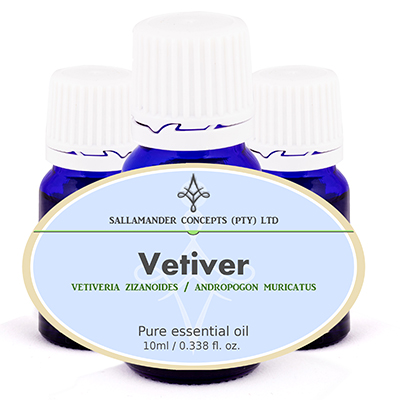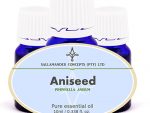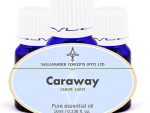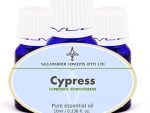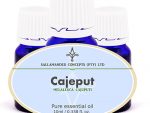Information on Vetivert essential oil
Vetivert essential oil is extracted from Vetiveria zizanoides (also known as Andropogon muricatus) of the Gramineae family and is also known as vetiver and khus khus.
Vetivert essential oil has a wonderful effect on the mind and body and is useful to dispel irritability, anger and hysteria, while having a balancing effect on the hormonal system and is a great boon for the skin. It is used to reduce wrinkles and stretch marks while nourishing and moisturizing the skin and helping wounds heal.
Oil Properties
It has an earthy, musty smell – much like the smell of a damp forest floor and is amber to olive in color.
Origin
Vetivert Essential Oil is a tall, tufted, perennial, scented grass with long narrow leaves and an abundant complex lacework of underground white roots and is mainly cultivated in the tropics, such as India, Tahiti, Java and Haiti.
The grass was used in Calcutta and Haiti for thatching and awnings, blinds and sunshades, while in Java the roots were used for weaving mats and thatching huts, which not only gave rooms an exquisite fragrance but also deterred insects.
It is a popular ingredient for soaps, toiletries and perfumes and growing the grass protects against soil erosion. Vetiver oil is also known as the ‘oil of tranquility’ because of its calming properties.
Extraction
It is extracted from the washed, chopped, dried and soaked roots and rootlets by steam distillation and yields about 0.5%.
Chemical Composition
The main chemical components are benzoic acid, vetiverol, furfurol, a and b-vetivone, vetivene and vetivenyl vetivenate.-terpinene, linalool, borneol, b-caryophyllene, thymol and carvacrol.
Precautions
Some vetivert oils contain isoeugenol which has been limited for use in products and should not exceed 0.02 in the finished product. Dilution rates should then be adjusted to suit.
As with most essential oils, this essential oil should be kept in a dark and cool place and should be stored in an airtight dark glass bottle (Preferably in the fridge at a temperature of around 4° Celsius / 39° Fahrenheit).
Please read our page with heading: Safety with Essential Oils before using this oil.
We recommend the following book as an excellent resource regarding safety:
Essential Oil Safety: A Guide for Health Care Professionals by Robert Tisserand & Rodney Young (#ad)
Therapeutic properties
The therapeutic properties of vetivert essential oil are antiseptic, aphrodisiac, cicatrisant, nervine, sedative, tonic, sedative and vulnerary.
For our glossary and explanation of these therapeutic terms, please click here
Uses
Vetiver essential oil calms and soothes the mind and helps to dispel anger, hysteria and irritability and neurotic behavior can also be reduced, as stress and tension is reduced. It revitalizes the body and helps with mental and physical exhaustion and is also used for general aches and pains, especially for rheumatism, arthritis and muscular pain, while relieving insomnia.
Burners and vaporizers
In vapor therapy, vetivert oil can be used for nervous complaints, dispelling hysteria, anger and irritability and also to relieve insomnia.
Blended in Massage Oil or in the Bath
In blended massage oil or diluted in the bath, vetivert essential oil can help with mental and physical exhaustion, nervous complaints, rheumatism and arthritic pain, insomnia as well as balancing the hormonal system and have a healing effect on the skin.
Blended in a Cream
In a cream or lotion, it can be used to moisturize and nourish the skin and is specifically beneficial for dry, irritated and dehydrated skin. It is also helpful in reducing wrinkles and stretch marks and to improve the tone of slack skin, as well as helping wounds to heal.
Suggested Dilution Rates
On the skin
Adult:
Face: 0.5% to 1.5%
Body: 1.5% to 3%
Bath: 1.5% to 4%
3 to 24 months:
Face: 0.25% to 0.5%
Body: 0.25% to 0.5%
Bath: Maximum of 0.5%
2 to 6 years:
Face: 0.5% to 1.5%
Body: 0.5% to 2%
Bath: 0.5% to 2%
6 to 15 years
Face: 0.5% to 1.5%
Body: 0.5% to 3%
Bath: 0.5% to 3%
Pregnancy
Face: 0.5% to 1.5%
Body: 0.5% to 2%
Bath: 0.5% to 2%
- When in doubt consult your doctor / medical professional before use.
- Most professionals and/or Aromatherapists will always err on the side of safety when giving advice regarding the use of essential oils and oleo resins during pregnancy.
- Quite a number of Aromatherapists advise that you should avoid all essential oils completely while pregnant, specifically during the first trimester. This is a very safe approach but may not be necessary at all.
Diffusers and Vaporisers
4 to 8 drops
General:
- When using for the first time – Always use the lowest dilution rate and build up slowly to the maximum. Stop using all essential oils on the skin if irritation or allergy occurs.
- Any advice or instruction received from a medical professional ALWAYS supersedes recommendations or advice found on this website. When in doubt consult your doctor / medical professional.
Summary
Vetivert oil has a calming and soothing effect on the nervous system and is helpful for muscular aches and pains, as well as having a positive effect on hormonal imbalance as well as relieving insomnia.
Blends
Although most essential oils blend well together, vetiver essential oil blends particularly well with Benzoin, Grapefruit, Jasmine, Lavender and Ylang-ylang.

